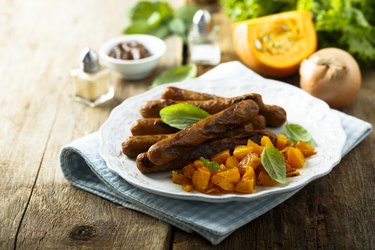
Sausage isn't exactly a health food — it's usually high in calories and full of fat, preservatives and fillers. But it's not all bad news: You can opt for turkey sausage instead of beef or pork sausage for a healthier meal.
"Minimally processed turkey sausage can be a great protein source at meals," Krista King, RDN, tells LIVESTRONG.com. Plus, it's lower in saturated fat and calories compared to pork sausage, she says. A bun-sized (2.6-ounce) turkey sausage link boasts 176 calories and 13 grams of fat while the same serving of pork and beef sausage has 297 calories and 27 grams of fat.
Video of the Day
Video of the Day
Since it's already assembled and seasoned, turkey sausage is an easy, convenient way to add protein to your breakfast or other dishes. "It's lean, delicious and cooks quickly because it's ground and compact," says Yankel Polak, head chef at ButcherBox. All you have to do is cook the sausage completely through, and you can do that with minimal mess and trouble by baking it in the oven.
How to Buy Turkey Sausage
"All types of sausage can be high in sodium," King notes. A turkey sausage link contains 479 milligrams of sodium, which is about 20 percent of the maximum amount of sodium the American Heart Association recommends per day (2,300 milligrams). Look for low-sodium options in the grocery store, advises King.
And seek out nitrite- and nitrate-free options, she suggests. These food additives are associated with increased cancer risk, according to a December 2015 meta-analysis published in the journal Nutrients. In general, King says, look for a short ingredient list that contains items that you recognize and can pronounce — that's a sign that the sausage does not contain additives or preservatives.
Read more: The Harmful Effects of Sodium Nitrite in Food
"Look for labels that read 'free-range' and 'all-vegetarian feed,'" recommends Polak. Check if the sausage has a Global Animal Partnership (GAP) certification label, which means that the turkey was raised on a vegetarian diet without any antibiotics or added hormones. These elements may require more time and expense from the farmer, Polak says, but they'll result in a more delicious turkey with higher quality meat.
How to Bake Turkey Sausages
What You'll Need
- Knife
- Cooking brush
- Cooking oil or melted butter (optional)
- Roasting pan or baking tray and aluminum foil
- Meat thermometer
- Tongs
How to Do It
- Preheat the oven to 350 degrees Fahrenheit for about 20 minutes.
- Cut turkey sausage links apart with a sharp knife. To help the sausages brown as they cook, you can brush them with a little cooking oil or melted butter — preferably unsalted, since sausage is usually fairly salty.
- Grease the rack of a roasting pan, oven-safe casserole or baking sheet and line the sausages without letting them touch each other.
- Put the sausages in the center of the oven. Turn them over using tongs after about 15 minutes to aid even cooking and to prevent burns from the roasting pan's rack.
- Bake the turkey sausages until they reach an internal temperature of 165 degrees Fahrenheit. It should take approximately 25 minutes, and the juices should run clear when you cut into a fully cooked sausage. When the sausage is firm throughout, that's another sign that it's completely cooked, says Polak.
Tip
1. Don’t bump the temperature higher than 350 degrees Fahrenheit, even if you’re in a hurry, says Polak. “With turkey sausage links, chances are they are in a casing and if the moisture inside begins to boil, the casing will burst and you’ll lose all the delicious juices,” he says. Plus, it’s messy.
2. Don’t use a fork to flip the sausages, since that could result in puncturing the casing and losing the moisture and flavor from the links. “Use tongs and be careful to keep the sausage intact,” says Polak.
How to Serve Your Baked Turkey Sausage
Turkey sausage is a delicious side at breakfast or in a sandwich. But those aren't the only two ways to serve it.
"I love using turkey sausage as the base for simple pasta dishes," says Polak. Bake the sausage whole in sauce so they retain their moisture, he says, and then let them rest before cutting the link. "With a little olive oil, garlic, tomatoes, fresh herbs and my favorite pasta, this is a perfect dinner that's full of flavor and a breeze to prepare."
Another option is to cover a lightly greased baking sheet with a layer of chopped bell pepper and red onion. Drizzle cooking oil and a bit of balsamic vinegar over them, sprinkle on salt and pepper to taste and place the sausages on top. Bake at the time and temperature specified above.
Read more: How to Make Oven-Baked Boneless Pork Chops
- USDA: "Sausages and Food Safety"
- USDA: "Turkey or Chicken Sausage"
- USDA: "Pork and Beef Sausage"
- American Heart Association: "How Much Sodium Should I Eat Per Day?"
- Nutrients: "Dietary Nitrates, Nitrites, and Nitrosamines Intake and the Risk of Gastric Cancer: A Meta-Analysis."
- Eating Well: Turkey Sausage Recipes
- We Are Not Foodies: Oven Baking Sausage: Quick, Easy and Minimal Mess
Was this article helpful?
150 Characters Max
0/150
Thank you for sharing!
Thank you for your feedback!